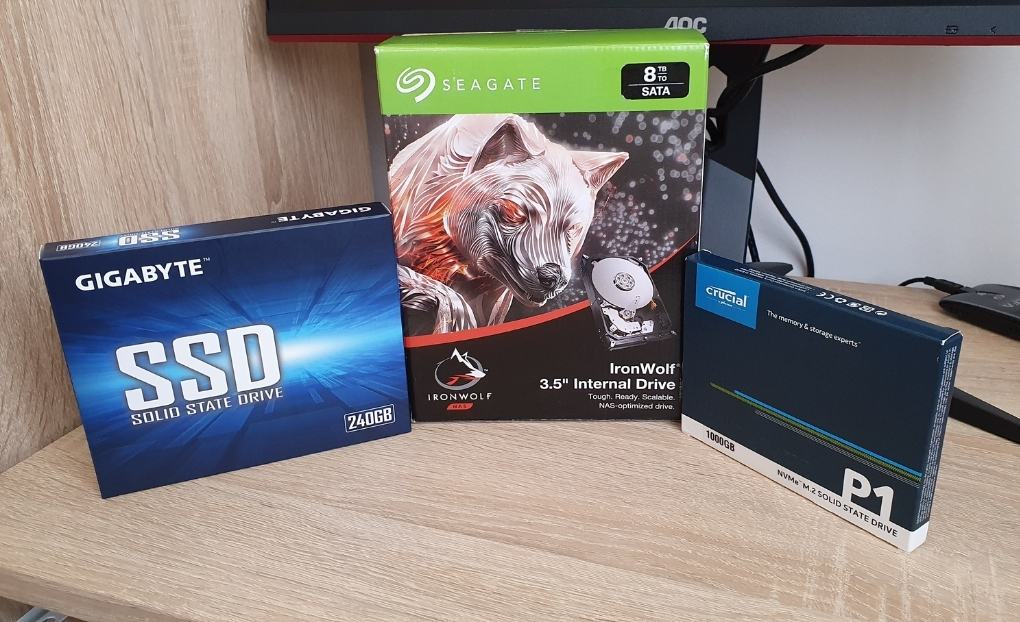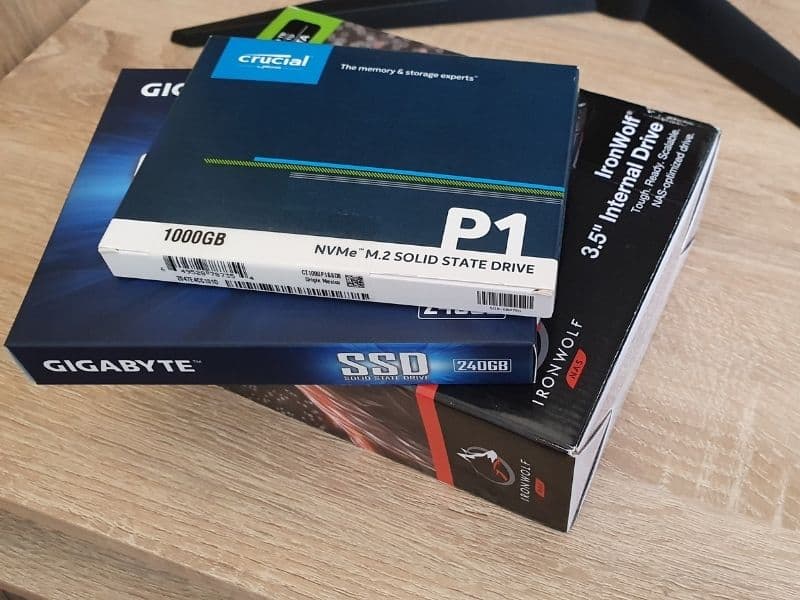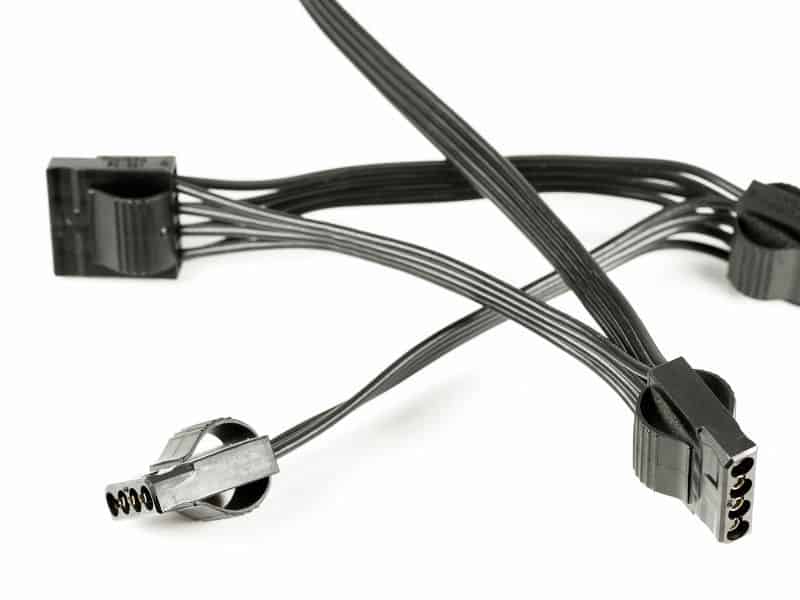If you have been wondering what’s the best storage for your gaming PC, I have to tell you that the question isn’t easy to say in a few sentences. The thing is very individual so what is enough for one user to another is small or slow. First of all, let’s differentiate with the usual terminology used when determining the storage space for your gaming PC.
Today you can get several popular devices for storing your data, such as Hard Disk Drive (HDD), Solid State Drive (SSD), and M.2 NVMe SSD.
Also, suppose we are talking about centralized data storage in a home network or business environment. In that case, we come across terms such as NAS and SAN. A particular type is Cloud storage, where you can rent the size of storage space that suits you.
Table of Contents
Recommendation for the best storage for your gaming PC
Here are a few suggestions for those who can’t wait and read the entire text, depending on your budget and what you do primarily on the computer.
Picture | Name | Details | Price |
SAMSUNG 970 EVO Plus 1TB |
| ||
WD Blue 500GB SSD |
| ||
Seagate BarraCuda 4TB |
| ||
Seagate 2TB External HDD |
| ||
Synology NAS DS220+ |
|
Suppose you are a severe gamer, programmer, or generally demanding user who doesn’t tolerate slow work and waiting. In that case, I recommend getting a PCIe NVMe M.2 drive of 512GB or more. In addition, store all your essential data on an internal HDD of at least 2TB.
Depending on your data’s importance, I recommend getting an external 2TB HDD to regularly back up your essential data from the internal HDD or SSD. Suppose you have a smaller local area network (LAN). In that case, I recommend storing your data on the NAS, providing data redundancy to protect it.
If you are a gamer or a less demanding user on a smaller budget, get an SSD of at least 240GB and an internal drive of at least 1TB. Set up the operating system (OS) and some essential applications you work with often on the SSD, and store your other data, videos, and music on the HDD.
You can also consider storing your data via the Cloud service (Google Drive, DropBox, etc.). However, some people still shy away from it because of the sensitivity and importance of their data.
How to choose storage?
For your gaming PC, it’s essential to choose a combination of storage that suits your needs and available budget. Choose a SATA 3 SSD with an internal HDD if you have a slightly thinner wallet. I suggest purchasing a PCIe NVMe SSD with 500 GB or more for more demanding users. Of course, before purchasing, see if your motherboard has a suitable M.2 slot for NVMe.
Storage devices can be divided into:
- internal,
- external, and
- a network according to storage methods.
Internal data storage
This category includes all devices you install in your ATX case or laptop. These are HDD, SSD, and M.2 NVMe SSDs.
HDD (Hard Disk Drive)
The HDD is the oldest, slowest, and largest storage device in this category. It consists of rotating magnetic disks on which magnetic heads write data. HDD is one of the oldest storage devices on a PC. It usually comes in the form of 3.5 ” or 2.5″ dimensions that determine where you install it. We install 3.5 “HDD disks in classic ATX cases or NAS, SAN, etc. The 2.5″ is primarily intended for installation in laptops and small ATX cases.
The primary task of the HDD is to store data permanently, whether the computer is turned on or not. Data must always be available until the hard drive stops working or crashes. If you only have an HDD on your computer (without SSD), we store everything: operating system (OS), installed applications, games, music, and movies.
SSD (Solid State Drive)
SSD is the successor to HDD designed to replace them, but there’s still a better $/MB ratio in favor of HDD. The classic SATA SSD is in 2.5 “format, and we usually install the operating system and applications on it. SSD is several times faster than HDD. We store data in memory chips (NAND Flash memory), similar to RAM. However, unlike RAM, the data remains permanently written to the SSD when we turn off the computer.
NVM Express (NVMe or non-volatile memory)
NVMe uses a much faster PCI-express motherboard interface to access memory. When connecting the NVMe disk to the motherboard via a PCI-ex interface, we connect with other hardware much faster than a classic SSD with a SATA (III) controller. The NVMe drive comes in several different shapes and sizes. You can often see the M.2 2280, which looks like a RAM module.
External data storage
This category includes all storage devices physically located outside the PC or laptop. We often mean the USB HDD, a 3.5″ or 2.5 “internal drive housed in a thin case with small electronics powered via a special adapter or USB cable. A USB 3.0 cable powers modern external drives. We use the same cable for power supply and data transfer. The advantage of a USB HDD is that it’s portable and suitable for storing data in case of a breakdown of your computer system.
In addition to USB HDDs, there are also USB SSDs that are similar in purpose to HDDs but with much faster performance and less capacity.
The third type is USB flash drives or USB sticks which are memory chips housed in a small case and powered via a USB interface. They have the same purpose and role as a USB HDD or USB SSD but smaller capacity. They are great for fast data transfer between computers, and thanks to their small dimensions, they are trendy.
You should note that the capacity of USB Flash drives has dramatically increased, and the price has decreased. In that way, they have become a serious competitor to USB HDDs and USB SSDs.
Network data storage
This category includes special network devices located in a local area, home, or small business. Network devices are closed storage systems that consist of multiple internal hard drives or SSDs. Access to these disks is possible only through the network and with special permission.
NAS
A typical example of a network-attached storage device is a NAS (Network-attached storage). It’s a device that comes in an empty case to which you add an HDD as desired and which has its operating system.
NAS enclosures that can hold 2 to 4 HDDs with the ability to create data redundancy in the event of a failure are extremely popular. Disks can come in various RAID 0 or RAID 1 configurations (RAID – redundant array of independent disks).
RAID is a concept designed to logically group multiple physical disks into a single unit to increase performance (RAID 0) or data protection (RAID 1 – mirroring).
It would help if you chose the NAS to receive a sufficient number of HDDs to store all your data with the simultaneous disaster protection provided by the redundancy, as mentioned earlier.
SAN
SAN (Storage Area Network) is a data storage system that you will not see in the home version but in large business environments, i.e., corporations.
These are usually large data storage systems based on server infrastructure. Serious data storage system is similar to NAS but with a lot more disks, redundant data protection, more power sources, etc. It’s usually a complete computer, a server with the task of managing data storage.
Cloud
Cloud storage allows you to store files on remote servers that you access over the Internet. Providers like Google Drive or Microsoft OneDrive maintain their servers and associated infrastructure and provide you access to your data for a fee.
This way of storing data is an upgrade of the SAN system. Over time, corporations have realized that storage costs in the Cloud are cheaper than in SAN.
Basics for choosing the suitable capacity
Storage Capacity
When choosing the best storage device for your PC, the most crucial parameter is capacity. We usually express storage capacity in MB (MegaByte), GB (GigaByte), and TB (TeraByte).
What do these sizes tell us?
Let’s look at simplified measurement quantities for storage capacity:
1000 MB = 1 GB, 1000GB = 1 TB. For example, you have a 2TB HDD (that is, 2000 GB = 2,000,000 MB).
Example 1:
Take, for instance, that one average MP3 song takes up about 5 MB.
How much can we roughly put music songs on this 2TB disc? It’s an impressive 400,000 MP3 songs.
Example 2:
The second story is about videos or formats and applied compression methods. Let’s say an average video size of 2GB in MP4 format.
Approximately 1000 videos fit on the mentioned 2TB HDD.
If you put some Blue Ray backups of your movies with an average size of 30GB, the 2TB HDD will fit about 66 videos.
I hope you now have an idea of the capacity of storage devices and what you need to count on when purchasing.
Read/Write Speed
In addition to capacity, another important factor can be the speed of access to your data or reading and writing to disks.
For example, it isn’t the same if the magnetic plates in the HDD rotate at 5400 rpm, 7200 rpm, or 10000 rpm.
SSD speed is in MB/s, and of course, it’s better to keep this number as high as possible.
For example, the SSD says 500/480 MB/s, which means that the data read speed is 500 MB/s, while the write speed is 480 MB/s.
A typical HDD with 7200 rpm has an average data transfer of 80 – 160 MB/s.
Type of Connection
The type of connection of the storage device to the motherboard can significantly affect the write/read speed.
The following types of connections are popular:
- SATA I (also known as SATA 1.5 Gb/s) – the first generation of SATA interface, has a bandwidth of up to 150 MB/s.
- SATA II (also known as SATA 3Gb/s) – the second generation of SATA interface that has a bandwidth of up to 300 MB/s
- SATA III (also known as SATA 6Gb/s) is the third generation of SATA interfaces with a bandwidth of up to 600MB/s.
SATA III is backward compatible with older SATA interfaces to put an old SATA HDD on this port. You may have another problem if you have a newer SSD and want to put it on an older motherboard with a SATA II interface. For example, your new SSD can reach a read and write speed of 540/500 MB/s according to specifications. If you place it on a motherboard with a SATA II interface, your SSD can reach 280/270 MB/s.
HDD and SSD use the SATA interface on the motherboard, while NVMe SSD uses a PCI-ex interface and M.2 slot. For example, the PCI 3.0 version of PCI Express technology offers a maximum transfer rate of about 1GB/s per channel.
The NVMe drive can work with 4 PCIe channels, theoretically 4 GB/s. M.2 PCIe NVMe SSD is the fastest device you can buy to write and read data. An excellent SSD can offer 560 MB/s read/write, so we can easily see the benefits of an NVMe drive.
Additional elements when choosing storage for your PC
Physical size
The size of the storage device is essential if you want to place your gaming components in a small or at least ATX case. If it’s a midi ATX or a large ATX case, you can install a 3.5 “HDD, while a smaller one is worth installing a 2.5” HDD. 2.5 “HDDs commonly work in laptops, but we can also find their application in small ATX enclosures, external storage devices, etc.
Noise
Note that HDDs make noise during operation due to moving mechanical parts inside them (rotary plates and data write/read heads). SSDs and NVMe drives don’t have these problems because they have no moving parts.
Reliability
The moving parts of an HDD make it less reliable than an SSD, but this is only partially true. Although the HDD is slow and less reliable, thanks to the built-in electronics and self-diagnostics, it can indicate the possible occurrence of a failure in time.
Sudden noise or so-called bad sectors signify that a drive will fail, and you need to back up your data to another drive. On the other hand, the SSD can suddenly die without any warning.
You have to handle the HDD gently and make sure it doesn’t fall out because you can make it unusable.
I don’t recommend moving the HDD abruptly during operation because the magnetic head may fall on the magnetic plate, leading to failure. Moving is especially sensitive for laptops’ HDDs.
The SSD has no problems with crashes and shifts during operation. You will not damage the disc and data.
Data Recovery
Thanks to already developed and mature recovery technology, it’s much easier to recover your data from a broken HDD than from an SSD.
Power consumption and heat
The HDD consumes more power and heats up more than the SSD. NVMe drives, on the other hand, although consuming little power, can get quite hot due to their position on the heated motherboard. I recommend installing a passive heatsink on the NVMe for extra heat dissipation.
Connection methods
There are two types of connections for your internal storage devices. It’s a connection for data transfer and power supply.
Data connection
Connecting your storage devices to the motherboard dramatically affects their overall performance;
- An HDD can use two data connections: an older IDE or a newer SATA interface.
- The SSD uses only the SATA interface, while the
- NVMe uses the M.2 slot on the motherboard.
Older HDDs use an IDE interface, but today it’s an outdated way of communicating with the motherboard, so I recommend avoiding them.
The NVMe SSD exchanges data via the PCI Express bus, and we physically place it in the M.2 slot on the motherboard. The advantage is the much higher writing and reading speed than the fastest SSD. Also, the advantage is that you don’t need a power cable for the NMVe disk, it’s enough to insert it into the M.2 slot, and it’s ready to work.
Power connection
In addition to the data cable to the storage devices, you must connect the power cord. Today’s current HDD and SSD devices use mainly SATA power cables.
Older IDE HDDs used a Molex connector from the power supply unit (PSU). The Molex connector is now commonly used by fans or some housing accessories.
The NVMe disk doesn’t require any power cord.
Conclusion
As you can read, choosing the best data storage for your gaming PC doesn’t have to turn into a nightmare. You have to think about your actual needs, read this text, and fit it into your planned budget.
Whether making a PC build for yourself or upgrading an existing PC, you can find suitable and reliable storage devices. Of course, you don’t have to take storage devices according to my recommendations, but you have good guidelines for choosing.
If you have any questions or suggestions, don’t hesitate to leave a comment.




















